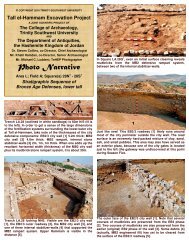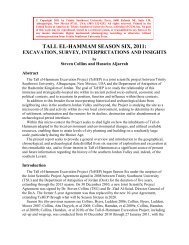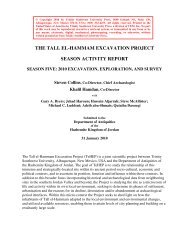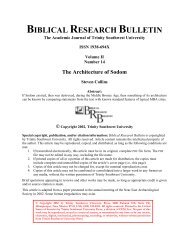Explorations on the - Tall el-Hammam Excavation Project, Jordan
Explorations on the - Tall el-Hammam Excavation Project, Jordan
Explorations on the - Tall el-Hammam Excavation Project, Jordan
Create successful ePaper yourself
Turn your PDF publications into a flip-book with our unique Google optimized e-Paper software.
from an analysis of those data categorically <strong>el</strong>iminates Bab-edh-Dhra and Numeira as viable<br />
candidates for Sodom and Gomorrah.<br />
APPLYING THE CRITERIAL SCREEN TO CANDIDATE SITES ON THE CIRCULAR<br />
PLAIN NORTH OF THE DEAD SEA<br />
As I have already argued, 31 <strong>the</strong> general locati<strong>on</strong> of <strong>the</strong> Cities of <strong>the</strong> Plain (kikkar) is clearly<br />
described in <strong>the</strong> book of Genesis—north of <strong>the</strong> Dead Sea <strong>on</strong> <strong>the</strong> east side of <strong>the</strong> <strong>Jordan</strong> River.<br />
Once <strong>the</strong> plain (<strong>the</strong> eastern Kikkar) was located, it seemed a ra<strong>the</strong>r straightforward process to<br />
determine what candidate sites existed within its boundaries: simply look at a map showing <strong>the</strong><br />
archaeological sites in <strong>the</strong> regi<strong>on</strong>. That sounded easy enough, but it turned out not to be so, and<br />
here is why. The area in questi<strong>on</strong> (see Map 7) is <strong>on</strong>e of <strong>the</strong> least studied in <strong>the</strong> archaeological<br />
literature. Not <strong>on</strong>ly had r<strong>el</strong>ativ<strong>el</strong>y little archaeological explorati<strong>on</strong> and excavati<strong>on</strong> been d<strong>on</strong>e in<br />
<strong>the</strong> regi<strong>on</strong>, 32 but also <strong>the</strong> area had been virtually ignored by biblically oriented archaeologists.<br />
That <strong>the</strong> area I have termed <strong>the</strong> eastern Kikkar has been practically invisible to American and<br />
Isra<strong>el</strong>i archaeologists is quite evident in <strong>the</strong> map segments reproduced as Map 7. For example, a<br />
map of “Main Excavati<strong>on</strong>s in <strong>the</strong> Holy Land” published in <strong>the</strong> most recent editi<strong>on</strong> of The New<br />
Encyclopedia of Archaeological Excavati<strong>on</strong>s in <strong>the</strong> Holy Land shows <strong>on</strong>ly <strong>on</strong>e site in <strong>the</strong> entire<br />
area. 33 Y. Ahar<strong>on</strong>i, in <strong>the</strong> revised editi<strong>on</strong> of The Land of <strong>the</strong> Bible: A Historical Geography,<br />
hardly touches <strong>on</strong> it, and shows Tuleilat <strong>el</strong>-Ghassul (or T<strong>el</strong>eilat Ghassul) (primarily Chalcolithic<br />
in date and, thus, too early to be <strong>on</strong>e of <strong>the</strong> Cities of <strong>the</strong> Plain) as <strong>the</strong> <strong>on</strong>ly archaeological site in<br />
<strong>the</strong> area. 34 Likewise, in The Archaeology of Ancient Isra<strong>el</strong>, edited by A. Ben-Tor, <strong>the</strong> period<br />
maps show no sites in <strong>the</strong> area except Tuleilat <strong>el</strong>-Ghassul for <strong>the</strong> Chalcolithic Period and Iktanu<br />
for <strong>the</strong> Intermediate Br<strong>on</strong>ze Age (still too early to qualify as <strong>on</strong>e of <strong>the</strong> Cities of <strong>the</strong> Plain). 35 In<br />
fact, if you examine any recent atlas of <strong>the</strong> Holy Land, 36 you will see <strong>on</strong>ly <strong>on</strong>e or two<br />
cities/towns listed for <strong>the</strong> area, and <strong>the</strong>n <strong>the</strong>y are mostly speculative locati<strong>on</strong>s of biblical cities,<br />
not sites whose identificati<strong>on</strong>s have been established via excavati<strong>on</strong> or rigorous geographical<br />
analysis.<br />
But if <strong>the</strong> biblical text can be trusted as an accurate representati<strong>on</strong> of <strong>the</strong> eastern Kikkar as it<br />
was during <strong>the</strong> Middle Br<strong>on</strong>ze Age, and if at least some remains of <strong>the</strong> Cities of <strong>the</strong> Plain<br />
survived destructi<strong>on</strong>, <strong>the</strong>n <strong>the</strong> criterial screen outlined above t<strong>el</strong>ls us what we should find <strong>the</strong>re:<br />
The eastern half of <strong>the</strong> circular plain of <strong>the</strong> sou<strong>the</strong>rn <strong>Jordan</strong> Valley immediat<strong>el</strong>y north of <strong>the</strong><br />
Dead Sea should c<strong>on</strong>tain <strong>the</strong> remains of two r<strong>el</strong>ativ<strong>el</strong>y large, fortified 37 MB cities (Sodom and<br />
31 See Collins, "Geography."<br />
32 The area was explored and sherded by Glueck, M<strong>el</strong>laart, de C<strong>on</strong>tens<strong>on</strong>, and <strong>the</strong> 1975/76 valley survey team of <strong>the</strong> <strong>Jordan</strong>ian<br />
Department of Antiquities, but very little <strong>el</strong>se has been d<strong>on</strong>e in <strong>the</strong> area up to <strong>the</strong> present time, except for <strong>the</strong> excavati<strong>on</strong> of <strong>the</strong><br />
Chalcolithic site, Tuleilat <strong>el</strong>-Ghassul (1920s, ‘30s, and ‘60s), past excavati<strong>on</strong>s at <strong>Tall</strong> Iktanu (including a few probes into nearby<br />
<strong>Tall</strong> <strong>el</strong>-<strong>Hammam</strong>), and <strong>the</strong> excavati<strong>on</strong> of <strong>Tall</strong> Nimrin which began in 1989 and c<strong>on</strong>tinued intermittently through <strong>the</strong> 1990s.<br />
33 See <strong>the</strong> maps published in <strong>the</strong> NEAEHL.<br />
34 See Ahar<strong>on</strong>i, Historical Geography.<br />
35 See A. Ben-Tor, ed., The Archaeology of Ancient Isra<strong>el</strong> (New Haven and L<strong>on</strong>d<strong>on</strong>: Yale University, 1992).<br />
36 For example, see J.J. Bims<strong>on</strong> and J.P. Kane, eds., New Bible Atlas (Leicester and Oxford: Inter-Varsity/Li<strong>on</strong>, 1985); and J.C.<br />
Laney, C<strong>on</strong>cise Bible Atlas (Peabody: Hendricks<strong>on</strong>, 1999).<br />
37 The fact that Lot sat “in <strong>the</strong> gateway of [Sodom]” (Genesis 19:1) clearly indicates <strong>the</strong> city was fortified.<br />
7












